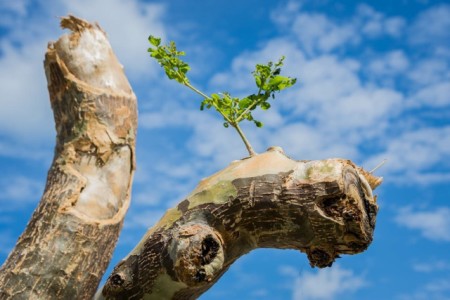
It has been an exhausting few weeks for many of BirdsCaribbean’s partners across the region. The hurricane season is not over for another two months, but Caribbean conservationists are hoping for a break. BirdsCaribbean and its wonderful supporters across the region are doing their best to keep up with a variety of urgent needs, from shipping hummingbird feeders for starving birds to organizing assessments and surveys. There is a lot of work to be done, but teamwork and partnerships are making the difference.
We at BirdsCaribbean extend our heartfelt thanks to all those who have donated towards the crowdfunding campaign so far. Your support means so much to us, as we try to help all our dedicated and hard-working partners get back on their feet after this unprecedented series of disasters. We assure you that the funds will be put to good use, and we will never forget the outpouring of kindness and generosity from folks near and far. It is quite humbling!
Time has passed slowly since the passage of Irma and Maria, and we have been extremely anxious for news from the islands most badly affected. Here are some updates on the bird populations. It is a very mixed picture, so far, so be prepared for good news, but some “not so good”:
BARBUDA
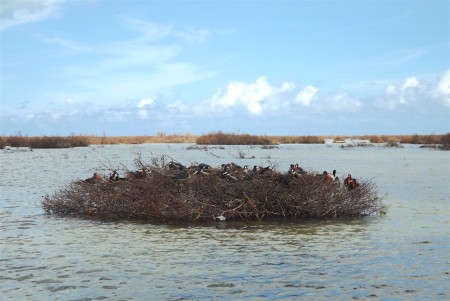
During their visit to the devastated island of Barbuda on September 22, the Environmental Awareness Group’s Andrea Otto and Junior Prosper were thrilled to count eight endemic Barbuda Warblers that had miraculously survived the fierce onslaught of Hurricane Irma – alongside Yellow Warblers. BirdsCaribbean is assisting with intensive surveys in mid-October to assess the population size and actions that can be taken in the short and long term to help the bird.
At Codrington Lagoon – home to the largest colony of Magnificent Frigatebirds in the Caribbean – the team was stunned, however, to find just one small group of 30 adult birds perched on a dead mangrove bush, instead of the usual thriving colony of 4,000 and 5,000 birds in the Sanctuary. The Antiguan team counted about 325 birds soaring in the air above the lagoon. We don’t know yet what has happened to all the other birds. Known as “Weather Birds,” frigatebirds will fly out before the storm hits, so hopefully they are still alive. There were juveniles in the colony not yet able to fly, however. They are known to climb deep into the mangroves and wait out storms, however, no young birds have been spotted. They most likely perished in the storm.
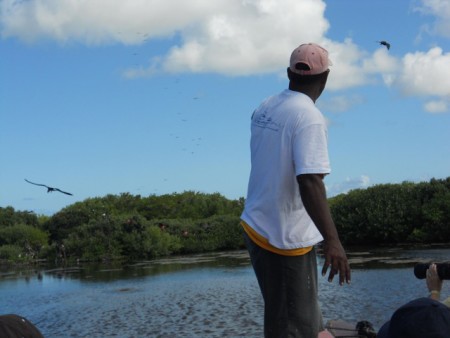
Otto described the Red Mangrove habitat of the lagoon as “burnt”—there was almost no remaining foliage. “Normally, the mangroves are so dense, lush and green that you have to crane your neck to see between and beyond them, and they are loaded with birds,” said Otto. “Now we could easily see for long distances into the sanctuary.” The trees that remained were shorter and stripped bare. The Barbudans with the team said they “barely recognized the landscape.”
The recovery of the lagoon’s mangroves is of grave concern. The Magnificent Frigatebird, considered one of the most threatened seabirds in the Caribbean, depends on mangroves to nest and roost at night. The sanctuary, which is well managed by the local community and patrolled by wardens, provides critical habitat for this species. It also provides sustainable livelihoods for local bird and nature guides that take people into the sanctuary by boat to witness the spectacular site and sound of frigatebird courtship—males puffing out their red neck pouches and drumming on them to attract a mate.
On Barbuda, the team found most large trees had been uprooted or broken. Trees and shrubs had no green or live leaves and there was “not even grass,” reported Junior Prosper. In other wetland areas on Barbuda, Willets, Brown Pelicans, Green Herons, Lesser Yellowlegs and Spotted Sandpipers, as well as Eurasian Collared Dove and a few Pearly-eyed Thrashers were seen. However, no West Indian Whistling-Ducks, a threatened regional endemic were spotted. An intensive survey effort will take place over the next several weeks.
What are the Barbuda Warbler’s prospects for survival? As with many other species on all the islands, this post-hurricane period is a critical time for the birds, because of the shortage of food. “My fear now is that with vegetation largely stripped of leaves, as photos indicate, insect food will be very hard to come by in the coming weeks. I fear more birds may be lost from food shortage post-hurricane than in the storm itself,” observes Tony Diamond (University of New Brunswick), who together with his graduate students has studied the warbler and frigatebirds. BirdsCaribbean will be working with EAG to look at habitat restoration actions that can be taken for the warbler and the frigatebirds.
In the sister island of Antigua, hummingbirds were “highly stressed” after the storms, according to Facebook posts. The Purple-throated Carib descended from upland forests to feed around towns and homes. In their normal habitats, flowers, fruits and insects are gone, and they have also lost secure space and even other members of their species, it was noted.
BAHAMAS
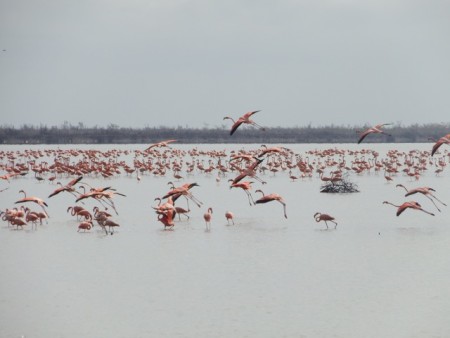
In the Bahamas, which fortunately did not bear the full brunt of the storms on all its many scattered islands – bird species appear to have been moving around quite a bit. The Bahamas National Trust (BNT), a key BirdsCaribbean partner, is on the lookout for Cuban Parrots (Bahama subspecies), which have been “conspicuously absent” from the eastern end of New Providence since Hurricane Irma. They may have moved temporarily elsewhere. “Those of us who live in the East have missed their early morning calls during their flyovers,” our BNT friends report. BNT Warden Randolph Burrows spotted over 100 parrots on the island of Great Inagua, which was hit hard by Hurricane Irma. Residents were also delighted to welcome thousands of American Flamingos on September 14, following the passage of the hurricane. Inagua is home to a breeding colony of 50,000 flamingoes, but there is a question as to whether some of these birds may have been refugees from Cuba and the Dominican Republic. BNT Executive Director Eric Carey, while happy to see the birds, observed: “Hurricanes such as Irma actually make us realize how much we do not know about our flamingos.”
CUBA
As for updates from our hard-working friends in Cuba, due to communication problems, we have received no further updates on the flamingo populations from the first report that thousands were killed in the storm. Nor have we learned how other endemic and rare species have fared such as the Zapata Sparrow and Zapata Wren. The photos show, however, that habitats on the northern coast and cays were severely damaged with many mangroves and other trees uprooted and stripped of vegetation as in Barbuda. We will report as soon as we receive news, which we hope will be positive!
DOMINICA
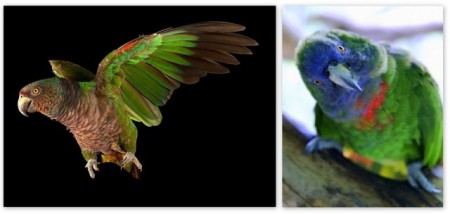
The eye of Hurricane Maria passed directly over the tiny island of Dominica, which is still reeling from the impact. The port is not yet fully functional for ships. The normally lush, green country, known as the “nature isle” for its stunning and majestic mountainous landscape is barren and brown at the moment. Stephen Durand reported that the devastation is heartbreaking and they are taking it one day at a time. The Forestry Office was severely damaged by the storm and all of its equipment looted. Several of our partners have lost their homes and there is a shortage of food and water in small, remote communities. Communications remain poor due to the mountainous terrain and the extent of damage to infrastructure, although aid is starting to come in via helicopter. Here there is great concern for the two endemic parrots – in particular the Critically Endangered Imperial Parrot (“Sisserou”)—only 400 of these are known to exist in the wild, with none breeding in captivity.
Lennox Honeychurch reported that he has seen some Red-necked Parrots (“Jaco”) flying around, even down to the coast…clearly disoriented, landing in the road looking for scraps of food. So they at least have survived. The fate of the Sisserou is as yet unknown. No one he has spoken to, even in the Carib territory, have seen any since Maria struck. Durand reports that a search for the Sisserou will begin today – we will share news as soon as it is available. While captive birds have survived, they also need food; a BirdsCaribbean member has taken over a small amount of parrot food, as well as bird feeders and powdered nectar for the hummingbird population.
GUADELOUPE
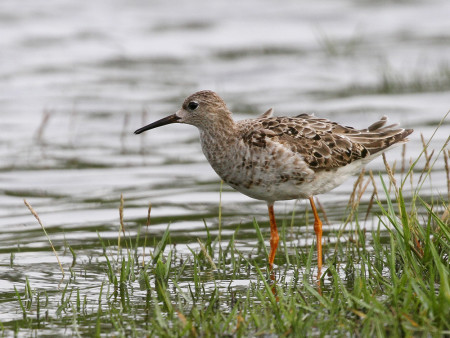
The island of Guadeloupe did not escape the wrath of the storms, receiving blows from both Irma and Maria and causing much damage to parks and protected areas. During an early survey on September 20, Anthony Levesque noted that the swamp areas were completely flooded. Just a few shorebirds were seen, including Great Egret, Semipalmated Plover, Ruff, Least Sandpiper, White-Rumped Sandpiper, Greater and Lesser Yellowlegs, and also two Belted Kingfishers. The following morning, a Green-Throated Carib was seen “fighting against the wind…” Since then, more shorebird sightings have been recorded.
ST. EUSTATIUS
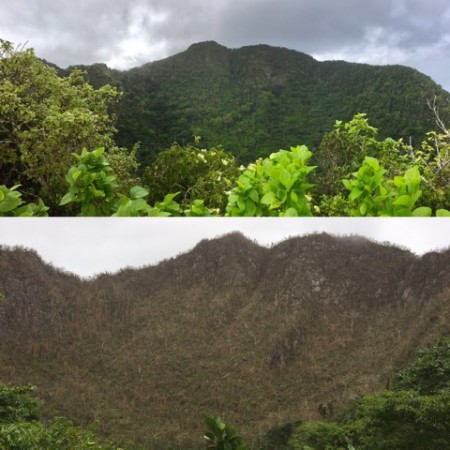
Although not badly impacted by the hurricanes, the small island of St. Eustatius (aka “Statia”) nevertheless suffered damage to many trees on the island and in the Quill/ Boven National Park, which includes the slopes of their dormant volcano, known as “The Quill.” The impacts on wildlife and ecosystems are not yet known. Hannah Madden is concerned about the impact on the endemic Bridled Quail-Dove population that she has been monitoring. BirdsCaribbean will fund an intensive survey of the dove next month. Hannah reports that they received some surprise visitors: A small flock of American Golden Plovers. This species has never been recorded on Statia before; they were likely blown off course by the hurricanes. Partners in other islands are also reporting vagrants and new species showing up – blown in or off course during migration from the hurricanes.
SINT MAARTEN
In Sint Maarten, conservationist Binkie van Es – who was himself made homeless by Hurricane Irma – reported that hummingbirds were of greatest concern, because of the lack of food. Binkie is excited to receive a shipment of 300 hummingbird feeders, on its way from BirdsCaribbean to Sint Maarten/St. Martin. These will be distributed to schools and homes across the island, with the assistance of Les Fruits de Mer and Environmental Protection in the Caribbean (EPIC). “I am afraid we lost half of our Brown Pelican population,” Binkie noted, while observing that White-cheeked Pintails appeared undisturbed. Barn Swallows, he noted, appeared to be displaced from their usual locations. Meanwhile, American Kestrels were finding happy hunting grounds, since the trees and bushes were stripped of leaves. Binkie notes: “Most regular shrubs and trees are sprouting already, but all mangroves took a terrible hit.” The mangrove habitats may take much longer to recover.
ST. MARTIN
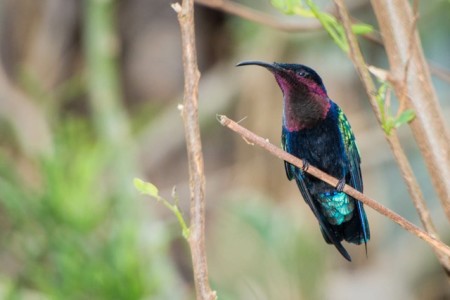
On the French side of the island, St. Martin, there was also huge damage to homes and infrastructure. Our partner organization, Les Fruits de Mer, also lost its museum building; fortunately, the contents were packed in a container for removal, so are safe. BirdsCaribbean’s Mark Yokoyama reports that he used ten pounds of sugar in two weeks, as hummingbird feeders he has set up are besieged with birds, including many Bananaquits, Green-throated Caribs, Antillean Crested Hummingbirds and others. Despite the storms’ impact, “hillsides are starting to green up,” our partners report and a few flowers (oleanders) are now blooming. EPIC reports that it will have a renewed focus and will be seeking funds for mangrove restoration in October; BirdsCaribbean will be assisting with these funds.
BRITISH VIRGIN ISLANDS
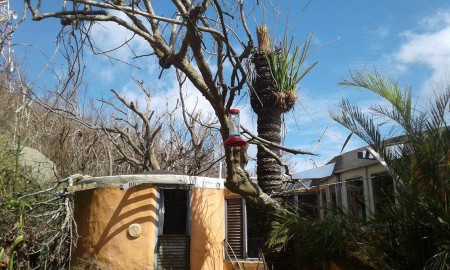
The British Virgin Islands were hard hit by both storms. Trees were stripped of leaves and many larger trees damaged or destroyed. The largest mangrove forest at Paraquita Bay was completely leafless. Elsewhere, small pockets of mangrove were already removed during the post-hurricane cleanup. This raises a general concern that the destruction of bird habitats, especially forested areas (already threatened in many places by development) may be accelerated by post-storm cleanups. A gas station may be built in their place, rather than the habitat being restored and replanted. “As usual, we try to save what’s left…” was the comment from Birdscaribbean member, Clive Petrovich, on Tortola – who also brought sad news that Bananaquit nests with eggs or young around his home were destroyed by the hurricanes, along with the foliage. He saw a few Bananaquits, and Pearly-Eyed Thrashers, Scaly-naped Pigeons, Kingbirds, Smooth-billed Anis and a few other species were spotted.
There are concerns here too for the hummingbird populations; some have been observed eating arthropods to survive. While bird numbers on Tortola have dropped dramatically, a number of trees (mahogany, sago palms) already have new leaves. Our partners in both the British and US Virgin Islands, which suffered similar devastation, are looking forward to receiving hummingbird feeders from BirdsCaribbean to help these nectar feeders survive during this period of severe food shortages.
PUERTO RICO
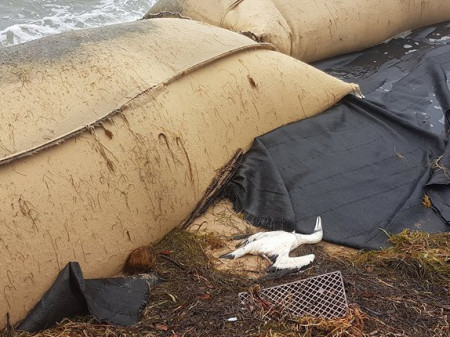
We are anxious to hear from our friends in Puerto Rico, and stand ready to assist in any way we can when communications are restored and their needs are established. Of particular concern is the Critically Endangered Puerto Rican Parrot. Reduced population size due to hunting and capture for the pet trade, combined with habitat loss and fragmentation, make this species especially vulnerable to large scale natural disasters. Also of concern is the fate of a number of endemic species in PR following the storm, such as the Endangered Yellow-shouldered Blackbird, Critically Endangered Puerto Rican Nightjar and Vulnerable Elfin-woods Warbler.
What is BirdsCaribbean’s focus in the near and medium term following these terrible storms?
At the moment we are organizing shipments of hundreds of hummingbird feeders and bird seed to our partners on all the islands that have been impacted; several shipments are en route! We will be helping to fund post-hurricane surveys of Bridled Quail-doves in Statia this fall, and also the intensive surveys of the Barbuda Warbler and Magnificent Frigatebird that will take place in mid-October. We will be helping the Forestry Dept in Dominica to replace all their bird monitoring field equipment, including binoculars, spotting scopes, GPS units, backpacks, cameras, and more. We have also been topping up cell phones for our partners so that they can communicate, and anticipate that we will funding mangrove and habitat restoration projects.
Again, we are truly thankful to all that have donated so generously to our ongoing fundraising effort for hurricane relief for our partners and beloved birds that has allowed us to help with recovery actions. We particularly wish our partner Vermont Center for Ecostudies and Kevin Loughlin of Wildside Nature Tours, who are supporting us with a GoFundMe site of their own (please donate as all funds raised up to $10K are matched by Wildside!).
This has been an extremely difficult time for BirdsCaribbean partners, for the birds – and for the people of the Caribbean. However, the islands are resilient, and we are confident that, while it will be slow, a steady recovery is underway. In fact, as each day passes, the region is slowly getting back on its feet. We plan to bring further bird updates as more reports roll in! Stay tuned.
By Emma Lewis and Lisa Sorenson (thanks to all of our partners that have been sending us news and photos – please keep it coming and let us know your needs!)
Scroll over or click on the photos for captions








I spoke with staff at the USFW SE region office in Atlanta on 9/27. They confirmed that the USFW facility staff and captive flock, which rode out the storm in the hurricane building, survived just fine.
On the 28th, a friend living in San Juan who was fortunate to have cell/internet service and a working generator, posted online that a local radio station reported that morning that 36 wild Puerto Rican Amazons had been seen and confirmed to have survived.
On Facebook there have been reports from both of the captive breeding facilities for the Puerto Rican Amazon.
Ricardo Valentin, at the Rio Abajo Aviary facility, confirmed in a brief post on 9/30 that the staff and captive flock which rode out the storm in the hurricane building are all fine and that “a significant number of wild ones survived.”
In a post on 10/9 Ricardo reports that the captive flock is fine and around 80 of the wild parrots survived, but the damage to the forest is significant, as is damage to the aviary.
On 10/2 Jafet Velez-Valentin, at the USFW El Yunque Aviary facility, confirmed in a brief post that all the staff and captive flock were fine. FWS firefighters are there with chainsaws helping to open trails. At that point, due to the severe damage in the forest, they had not yet been able to access the area where the wild flock is.
There have not yet been any further posts from Jafet.
Also, I highly recommend the Facebook group Biodiversidad de Puerto Rico as a source for photos, videos, and reports confirming the survival of species – bees, birds, bats, the coqui (frogs,) snakes, turtles, and more have been documented and the page is now pretty active.
Thank you so much for the updates on the birds of these decimated islands. It was my first thought as the storms were passing through and I hope you will continue to keep us posted.
Thank you so much for all you are doing to assist birds in the effected areas. I will make a go fund me donation tomorrow and have shared the link on my fb page.
So touched by your dedication to the beauties.
Thank you for this important information about the hurricane’s impact on birds and habitats. We’ve been to Cuba and seen the flamingos there on the north side. I hope they are all right.
Thank you for all the wonderful work you’re doing to save the birds in the Caribbean.
Thanks for writing Marion! How wonderful that you have been to Cuba and send the gorgeous flamingos on the north coast. We have heard that many have been killed but don’t have a recent update on how they are doing. We will share news as soon as we have it. Best, Lisa
Dear Cathy, We are grateful for your kind words and donation. We are indeed dedicated to the Caribbean’s beauties – they enrich our lives and need looking after too! Warm greetings, Lisa
Dear Debbie, News continues to come in from our partners; we will keep you updated on our blog and social media. Thanks for your concern! Warm regards, Lisa
Dear Sam, Thanks so much for this informative update on what is happening in PR – sorry I missed seeing this earlier. Some of the early reports are indeed encouraging about the survival of the parrots, but I heard recently that the population at El Yunque has still not been located. We are hoping they have dispersed to other areas and pockets of forest and are finding food and still alive! Please keep in touch! Best, Lisa p.s. Thanks for the tip on the FB group.